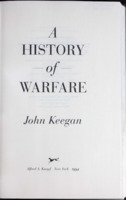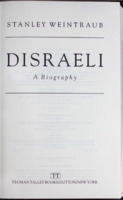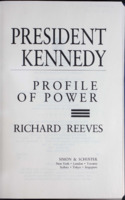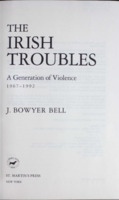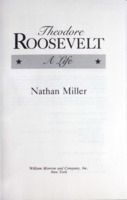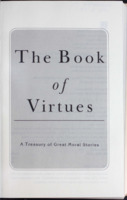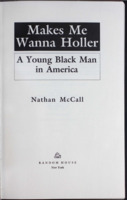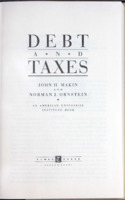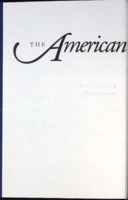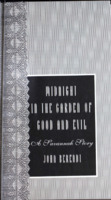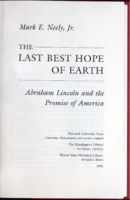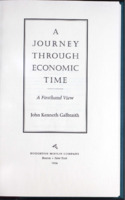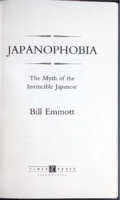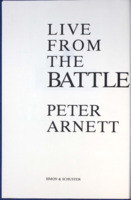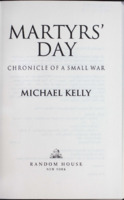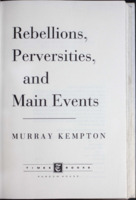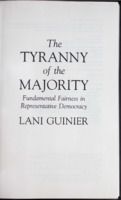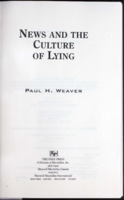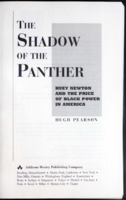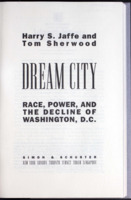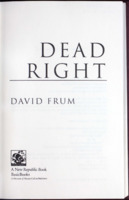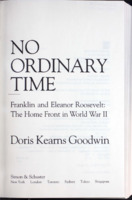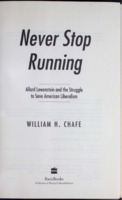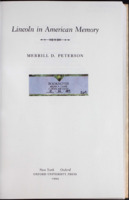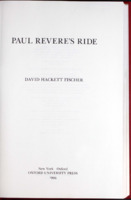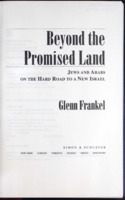Search
728 items
-
A history of warfare
Examines the place of warfare in human culture and the human impulse toward violence. -
Disraeli : a biography
Through the life of Disraeli we see Victorian England--her class system, social intrigues and prejudices, which allowed him to rise to prime minister. -
President Kennedy : profile of power
The author offers a study of Kennedy as crisis manager. He presents Kennedy as neither an amoral playboy nor the ruler of Camelot but a poorly prepared president with mediocre congressional experience. Each chapter presents a different day in the administration--a unique format that effectively reveals how Kennedy responded to simultaneous harrowing issues. The Berlin Wall, the Cuban Missile Crises, Vietnam, and the diplomacy of arms reduction illustrate how Kennedy was constrained by the unshakable Cold War fear of monolithic communism. This approachable investigation of Kennedy's use of power provides a thorough, even-handed review of the Kennedy years. -
Muddy boots and red socks : a reporter's life
A war correspondent recounts his thirty years of experience in the field covering stories all over the globe, from Cuba and Argentina to Vietnam and Saudi Arabia. -
The Irish troubles : a generation of violence, 1967-1992
History of the conflict that has made the term "Northern Ireland" synonymous with bloodshed and disorder for the past quarter century. -
Theodore Roosevelt : a life
As the twenty-sixth president of the United States from 1901 to 1909, Roosevelt embodied the overwhelming confidence of the nation as it entered the American Century. With a fierce joy, he brandished a "Big Stick" abroad and promised a "Square Deal" at home. He was the nation's first environmental president, challenged the trusts, and, as the first American leader to play an important role in world affairs, began construction of a long-dreamed-of canal across Panama, and he was awarded the Nobel Peace Prize for almost single-handedly bringing about a peaceful end to the Russo-Japanese War. In addition to following Roosevelt's political career - from his role as a youthful reformer battling New York City's corrupt Tammany Hall machine to his term as New York State governor to his presidency, in which he established the progressive agenda, to his ill-fated run on the third-party Bull Moose ticket in 1912 - Theodore Roosevelt examines the man as well. This book looks deeply into his personal relations with his close associates and his family, his children, and particularly the two women he married. Theodore Roosevelt presents a three-dimensional portrait of a man of flesh and blood who confronted life-wrenching tragedies as well as triumphs. -
The book of virtues : a treasury of great moral stories
Well-known works including fables, folklore, fiction, drama, and more, by such authors as Aesop, Dickens, Tolstoy, Shakespeare, and Baldwin, are presented to teach virtues, including compassion, courage, honesty, friendship, and faith. -
Makes me wanna holler : a young Black man in America
Examining the complexities of the problems of black youths from an insider's perspective, an African-American journalist recalls his own troubled childhood, his rehabilitation while in prison, and his successful Washington Post career. Reprint. 150,000 first printing. The author remembers his journey from a working class African American neighborhood to prison to a prestigious position on the Washington Post. -
Debt and taxes
No subject arouses - and perplexes - Americans more than debt and taxes. They are agreed about only one thing: they would like to rid themselves of both. It is a fantasy of course, as Benjamin Franklin knew when he observed in 1789 that "in this world nothing is certain but death and taxes." The only certainty Franklin neglected to mention was the lasting controversy that these confounding issues would always provoke.Debt and Taxes is a fresh look at America's budget mess by two of the country's most respected experts. John H. Makin, author of The Global Debt Crisis, and Norman J. Ornstein, an election consultant to CBS News and a contributor to The MacNeil/Lehrer NewsHour, provide a compelling and enlightening history of fiscal policy in the United States. They demonstrate how the political and economic aspects of the problem must be seen in broader patterns of ideology and philosophy. They trace our budget problems from the debate between Jefferson and Hamilton on how our government should work to the surprising struggles to formulate its policy. Most important, the authors examine where our policies are taking us, where they should be taking us, and how we can make our budget process more effective. The purpose of this book is to look behind he popular excitement over debts and deficits and to ask why and how we became entangled in our current predicament; how the fiscal struggles of the 1980s and early 1990s fit into historical patterns of political and economic thought concerning debt and taxes; and how much of the budgetary process is a real problem. Throughout the book, the authors take pains to place the subject in historical perspective. They point out that debate about the moral and political consequences of government debt, the power to tax, and the role of government itself lay behind both the Revolutionary War and the establishment of the republic. Sound fiscal policy was central to the Founding Fathers' philosophical and practical struggle over the direction that the new nation was to take. Debt and Taxes is an eye-opening - indeed, magisterial - account of the origins of the mechanisms of change and the belief in structural reform, of the competition between President and Congress, and of the philosophical and practical continuities, despite real and distinct changes, in public policy on taxing, spending, and debt. It is, as Senator Daniel Patrick Moynihan observes, "a clarifying, liberating book," one that all Americans should read. -
The American presidency : an intellectual history
Historian Forrest McDonald's work on the history of the American presidency . -
Midnight in the garden of good and evil : a Savannah story
Shots rang out in Savannah's grandest mansion in the misty, early morning hours of May 2, 1981. Was it murder or self-defense? For nearly a decade, the shooting and its aftermath reverberated throughout this hauntingly beautiful city of moss-hung oaks and shaded squares. John Berendt's sharply observed, suspenseful, and witty narrative reads like a thoroughly engrossing novel, and yet it is a work of nonfiction. Berendt skillfully interweaves a hugely entertaining first-person account of life in this isolated remnant of the Old South with the unpredictable twists and turns of a landmark murder case. "It is a spellbinding story peopled by a gallery of remarkable characters: the well-bred society ladies of the Married Woman's Card Club; the turbulent young redneck gigolo; the hapless recluse who owns a bottle of poison so powerful it could kill every man, woman, and child in Savannah; the aging and profane Southern belle who is the "soul of pampered self-absorption"; the uproariously funny black drag queen; the acerbic and arrogant antiques dealer; the sweet-talking, piano-playing con artist; young blacks dancing the minuet at the black debutante ball; and Minerva, the voodoo priestess who works her magic in the graveyard at midnight. These and other Savannahians act as a Greek chorus, with Berendt revealing the alliances, hostilities, and intrigues that thrive in a town where everyone knows everyone else." "Midnight in the Garden of Good and Evil: A Savannah Story is a sublime and seductive reading experience. Brilliantly conceived and masterfully written, this enormously engaging portrait of a most beguiling southern city is certain to become a modern classic."--BOOK JACKET. -
The Roosevelts : an American saga
The story of the Roosevelts is usually seen as a tale of two presidents - Theodore and Franklin - who were distant cousins from distinct worlds, separated by time and politics. And of two families - the Oyster Bay and Hyde Park branches - that had little to do with each other. Now comes an explosive new portrait, The Roosevelts: An American Saga, which offers a completely unique view of America's longest lasting and most powerful dynasty. The Roosevelts were one family, an exclusive elite who began their history intimately related by bonds of love and ambition. In this brilliant biography, we see for the first time how the family divided into two branches and began an epic battle for the family legacy. We see for the first time how the ideals of two presidents were passed on to members of later generations, ennobling some and crushing others. The Roosevelts is a rare look at what brought this exceptional group of people together and what drove them apart. In this riveting book we see Teddy, the flamboyant politician and Rough Rider, who was also a "Papa Bear," passing on an ethos of sacrifice and achievement to his "cubs." There is Theodore Jr., the "crown prince," handpicked by his father to carry on the traditions of Oyster Bay but unable to complete the mission. And Alice, Teddy's acid-tongued and fiercely loyal daughter, whose antics became the talk of Washington and who finally became a caricature, raving against her cousin's New Deal and trying desperately to preserve her father's legacy. There's also Eleanor, daughter of Teddy's tragic brother, Elliott, who translated the unhappiness of her marriage to FDR into political activism, eventually becoming First Lady of the World. And finally there is Franklin, always underestimated by Teddy's family, who made an alliance with Eleanor to become the nemesis of the Oyster Bay Roosevelts and, in the web of ironies that bind this family together, a truer heir to Teddy than any of his own children. Filled with drama and anecdote, presenting familiar characters in a penetrating new light, The Roosevelts is a soaring tale of triumph over heartbreak and frailty. But it is also a daunting story of the vanity of human wishes. -
Warriors don't cry : a searing memoir of the battle to integrate Little Rock's Central High
In 1957 Melba Pattillo turned sixteen. That was also the year she became a warrior on the front lines of a civil rights firestorm. Following the landmark 1954 Supreme Court ruling, Brown v. Board Education, she was one of nine teenagers chosen to integrate Little Rock's Central High School. This is her remarkable story. You will listen to the cruel taunts of her schoolmates and their parents. You will run with her from the threat of a lynch mob's rope. You will share her terror as she dodges lighted sticks of dynamite, and her pain as she washes away the acid sprayed into her eyes. But most of all you will share Melba's dignity and courage as she refuses to back down. -
The last best hope of earth : Abraham Lincoln and the promise of America
Mark R. Neely, Jr., provides for the general reader the first compact biography of Abraham Lincoln based on new scholarship. There is no comparable, succinct work on this nation's greatest president. "The Last Best Hope of Earth vividly recaptures the central place of politics in Lincoln's life. In Illinois, Lincoln was an established and prosperous lawyer, married to a refined and educated southern belle, and the father of four boys. Throughout his life, however, politics remained his first love. In Neely's depiction of Lincoln, power was never sought for its own sake. Having triumphed over the hardscrabble circumstances of his youth in Kentucky and Indiana, Lincoln, early in his political career, tied his ambition to the search for solutions to the economic underdevelopment of the American West. And in the last eleven years of his life, Lincoln's political ambitions became yoked to a fierce nationalism and a keen moral purpose - the preservation of the Union and the demise of slavery. Lincoln could not remember a time when he did not hate slavery, or revere the federal system. He made his position clear in the decade leading up to his presidential election campaign, and a civil war erupted." "Through Neely's eyes we see the growth of this president's advanced ideas about military strategy, despite their price in blood; his husbanding of the resources of the home front, regardless of its cost in national treasure; and his complex defense of the Constitution, notwithstanding a momentary loss of civil liberties. We also see Lincoln's steadfast dedication to the Emancipation Proclamation, while the fate of the republic and the future of four million black Americans hung in the balance." "Richly illustrated, nuanced and accessible, written with attention to the age in which Lincoln lived, yet ever alert to universal moral questions, this is a portrait of Lincoln as an extraordinary man in his own time and ours."--BOOK JACKET. -
A journey through economic time : a firsthand view
John Kenneth Galbraith exhibits unmatched insight and broad scope - from World War I and the Russian Revolution to the implications of Communism's fall, from the "superbly insane decade of the twenties" and the Great Depression to the Reagan era and beyond. Whether he is analyzing the advent of Keynesian theory or the end of colonialism and the emergent Third World, Galbraith epitomizes the hindsight and the vision of one who has been an active and outspoken participant in the world's economic history. He writes with authority about the forging of Kennedy's New Frontier and Johnson's Great Society and examines the consequences of the "unintended history of the 1980s." Keenly observed and brilliantly composed, A Journey Through Economic Time is the crowning achievement of a remarkable career, a comprehensive and accessible view of twentieth-century economic and political history that will be read and referred to for years to come. -
Japanophobia : the myth of the invincible Japanese
Bill Emmott's work on Japanese corporate entities. -
Live from the battlefield : from Vietnam to Baghdad : 35 years in the world's war zones
Peter Arnett is undeniably the dean of his generation's war correspondents, a breed apart. Daring, wily, willing to put himself at enormous risk for a story. Arnett is a thinking man and a man of action. From his youth in New Zealand in the 1940s, Arnett knew journalism would be his ticket to the world. And it was - to Bangkok; then to Laos, where Arnett swam across the Mekong River to file his dispatches from Thailand; and then on to Indonesia, where he traveled with Sukarno until he was expelled after only thirteen months for his reporting on the developing war.In 1962, Arnett was sent to Vietnam along with David Halberstam, Neil Sheehan, Mal Browne, Stanley Karnow and the rest of a new young group of foreign correspondents that would later include Dan Rather, Ted Koppel and Peter Jennings. When American ground forces were committed, Arnett went right in with them. His controversial coverage for the Associated Press incurred the wrath of President Johnson but won him a Pulitzer Prize. After the fall of Saigon, when many of his peers had gone, Arnett stayed behind to get the whole story.With the dedication, passion and intelligence that one finds in great foreign correspondents, Arnett has pursued the whole story ever since. After covering wars in Cyprus and Lebanon, he joined CNN in 1981. News was going live, twenty-four hours a day, and Arnett was going with it - from San Salvador to Moscow to Iraq. And then to Afghanistan, after the defeat of the Soviet-sponsored government, a place of anarchic conflict, where Islamic radicals plot to export terrorism to the mainland United States. Satellite communications have forever changed the way we see war. Arnett's on-the-ground reporting of the Gulf War from Baghdad had an immediacy and suspense we had not experienced before. No one who watched will ever forget. Now, in the same vivid eye-of-the-Desert-Storm way in which he reported the drama and danger of the Gulf War, Peter Arnett shares the adventures, the gambles and the glory of his lifemore than thirty-five years inside the world's war zones. -
Martyrs' Day : chronicle of a small war
Michael Kelley's work on the Gulf War. -
Rebellions, perversities, and main events
In today's society, the model citizen is too often one with neither memory nor traditions. Murray Kempton's refusal to relinquish either is among his greatest achievements. He knows that the chaos of daily events can only be understood through the prism of the past. He is a man suffused with a seemingly inexhaustible appetite for the life of the mind. He is that rare reporter whose skepticism has never succumbed to cynicism. -
The tyranny of the majority : fundamental fairness in representative democracy
Jurist Lani Guanier's commentary on the state on American Democracy. -
News and the culture of lying
Paul Weaver's commentary on the news media. -
The shadow of the panther : Huey Newton and the price of Black power in America
In the early morning of August 22, 1989, on the corner of Ninth and Center Streets in Oakland, Huey Newton faced Tyrone Robinson and two other drug dealers, asking them for crack. Robinson refused, took a 9-mm automatic from one of his companions and pointed it at Newton's head. Huey stood still and said, "You can kill my body, but you can't kill my soul. My soul will live forever!" Robinson shot him three times in the head. Huey Newton, once considered the nation's premier symbol of black resistance to the entire American power structure, was pronounced dead at 6:12 a.m. The Shadow of the Panther is the most ambitious, engaging, and balanced history of the Black Panthers to date. It is also an unflinchingly honest account of what amounts to human tragedy. Hugh Pearson's account of Huey Newton's rise to power and descent into addiction and powerlessness is set against a century-long quest for civil rights and empowerment. Beginning with the formation of the Brotherhood of Sleeping-Car Porters in the 1920s, Hugh Pearson then traces the development of civil-rights activism through a series of "Premier Negro Leaders" from Booker T. Washington, W. E. B. Du Bois, and Adam Clayton Powell, Jr., to Martin Luther King, Jr., Stokely Carmichael, and Malcolm X. The extraordinary progress and crushing defeats of the early- and mid-1960s set the stage for the rise of the Black Power Movement and its offspring, the Black Panther Party. The details of this evolution from nonviolence to violence, and, finally, to militarism, are presented here with clarity and insight, showing clearly how Black Power spelled the beginning of the end of the Civil Rights Movement, and paved the way for the emergence of the Panthers as the nation's primary symbol of black disenchantment. Through meticulous research and exclusive cooperation from many of those close to Newton, Pearson paints a detailed portrait of life in the Party. Newton's own opposing tendencies - the intellectual who earned a Ph.D. and the street thug - had parallels in the structure and activities of the Party: while creating positive change through political organization and community programs, the Party also had all the characteristics of a violent, repressive, gangster mob. Persistent problems with internal conflicts, the wide gap between Newton's elite corps and rank-and-file members, sexual abuse and mistreatment of women, and the abandonment, torture, and frequent murder of members and ex-members all contributed to the ultimate demise of the Party. The result is a fine-grained portrait of the complex and evolving relationship of revolutionary blacks and white leftist college students in the face of growing black militancy and the Vietnam War, and a vivid and varied cast of characters that includes Stokely Carmichael, James Forman, Bob Scheer, Elaine Brown, and David Horowitz. A powerful and undeniably bold take on an era both pivotal and persistent in the American consciousness, The Shadow of the Panther will no doubt be the benchmark for all future books on Huey Newton and the Black Panther Party. -
Colored people : a memoir
Memoir by Henry Louis Gates. -
Dream city : race, power, and the decline of Washington, D.C.
Harry Jaffe's work on the city of Washington, D.C. -
Dead right
David Frum's work on the conservative movement during the Reagan-Bush years. -
No ordinary time : Franklin and Eleanor Roosevelt : the home front in World War II.
Biographical work on Eleanor Roosevelt by Doris Kearns Goodwin -
Never stop running : Allard Lowenstein and the struggle to save American liberalism
Lowenstein became famous for the "dump Johnson" movement in 1968, Robert Kennedy's campaign for the presidential nomination and for being on Nixon's infamous "enemies list." -
Lincoln in American memory
Lincoln's death, like his life, was an event of epic proportions. When the president was struck down at his moment of triumph, writes Merrill Peterson, "sorrow - indescribable sorrow" swept the nation. After lying in state in Washington, Lincoln's body was carried by a special funeral train to Springfield, Illinois, stopping in major cities along the way; perhaps a million people viewed the remains as memorial orations rang out and the world chorused its praise. It was the apotheosis of the martyred president - the beginning of the transformation of a man into a mythic hero. In Lincoln in American Memory, historian Merrill Peterson provides a fascinating history of Lincoln's place in American thought and imagination from the hour of his death to the present. In tracing the changing image of Lincoln through time, this wide-ranging account offers insight into the evolution and the struggles of American politics and society - and into the character of Lincoln himself. Westerners, Easterners, even Southerners were caught up in the idealization of the late president, reshaping his memory and laying claim to his mantle, as his widow, son, memorial builders, and memorabilia collectors fought over his visible legacy. Peterson also looks at the complex responses of blacks to the memory of Lincoln, as they moved from exultation at the end of slavery to the harsh reality of free life amid deep poverty and segregation; at more than one memorial event for the great emancipator, the author notes, blacks were excluded. He makes an engaging examination of the flood of reminiscences and biographies, from Lincoln's old law partner William H. Herndon to the poet Carl Sandburg and beyond. Serious historians were late in coming to the topic; for decades the myth-makers sought to shape the image of the hero president to suit their own agendas. He was made a voice of prohibition, a saloon-keeper, an infidel, a devout Christian, the first Bull Moose Progressive, a military blunderer and (after the First World War) a military genius, a white supremacist (according to D.W. Griffith and other Southern admirers), and a touchstone for the civil rights movement. Through it all, Peterson traces five principal images of Lincoln: the savior of the Union, the great emancipator, man of the people, first American, and self-made man. In identifying these archetypes, he tells us much not only of Lincoln but of our own identity as a people. This absorbing book leads us on a revealing tour through our changing image of our greatest president - and our changing image of ourselves. -
Paul Revere's ride
David Hackett Fischer's account of Paul Revere's ride from the perspective of both Revere and British General Thomas Gage. -
Beyond the promised land : Jews and Arabs on the hard road to a new Israel
Glenn Frankel's work on the status of government, politics, the economy, and relations between jews and arabs in the modern state of Israel.
